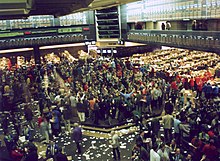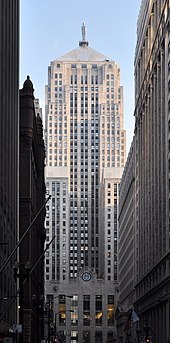Chicago Board of Trade
The Chicago Board of Trade ( CBOT ), founded in 1848, is the world's oldest futures exchange and part of the CME Group . More than fifty different futures transactions are processed by over 3,600 CBOT members, both through floor trading and electronically . The volume on the stock exchange in 2003 reached a record high of 454 million contracts. On July 12, 2007, the merger of the CBOT with the Chicago Mercantile Exchange became the new CME Group.
history
Due to concerns of US traders that there might be a shortage of buyers or sellers of raw materials, they developed forward contracts, especially for agricultural products such as grain, pork bellies, etc. The CBOT was a centralized trading place where buyers and sellers could meet to negotiate their contracts and complete. In 1864, the CBOT introduced the first standardized exchange-traded forward contracts. In 1919, the Chicago Butter and Egg Board , a spin-off of the CBOT, was reorganized to accommodate futures trading and the name was changed to the Chicago Mercantile Exchange.
On October 19, 2005, CBOT went public with 3,191,489 shares at US $ 54.00 per share. Over the course of the day's stock trading on the New York Stock Exchange , the price rose 49% to $ 80.50. In 2007, the CBOT and the CME merged to form the CME Group.
building
Since 1930, the Chicago Board of Trade has been located at 141 West Jackson Boulevard in Chicago. The building was designed by the architects Holabird & Root . At 184 meters tall, it was the tallest building in Chicago until 1965 when the Richard J. Daley Center was built. The building is in Art Deco style, with sculptures by Alvin Meyer ; at the top is a 9.5 m statue of the goddess Ceres , alluding to the history of the stock exchange as a raw material and grain market. The Ceres figure has no face because the sculptor, John Storrs , believed the 45-story building was so much taller than any other structure in the area that no one would be able to even look at the face. Today, the building (which was recognized as a National Historic Landmark on June 2, 1978 ) is surrounded by other (sometimes even larger) skyscrapers in the Chicago Loop's financial district .
The pit
The Pit is a raised octagonal structure where floor trading takes place. There are many such pits on the floor of the CBOT. The outside steps up and the inside steps down at such pits give them an amphitheater look and allow hundreds of traders to see and hear each other during trading hours. The importance of the pit and the trade there is underlined by the use of a stylized pit as the logo of the CBOT. The Pit is also the title and subject of a classic 1903 novel by Frank Norris .
Individual evidence
- ^ CME Group
- ↑ Listing of National Historic Landmarks by State: Illinois. National Park Service , accessed July 22, 2019.
- ↑ http://www.gutenberg.org/etext/4382
literature
- Michael Durica: Product Development for Electronic Derivative Exchanges. The case of the German ifo business climate index as underlying for exchange traded derivatives to hedge business cycle risk. Pro Business, Berlin 2006, ISBN 3-939533-05-X (also: Trier, University, dissertation, 2006).
- Oliver Ryan: Chicago's Making A Contracts Killing. In: Fortune , November 14, 2005, p. 22.
Web links
- Chicago Board of Trade
- CBOT - CBOT Membership Overwhelmingly Approves Restructuring
- Chicago Landmarks: Chicago Board of Trade Building
- News on the Merger: Chicago bulls
- CBOT Resource Center of Top Brokers
Coordinates: 41 ° 52 ′ 40.2 " N , 87 ° 37 ′ 56.2" W.


